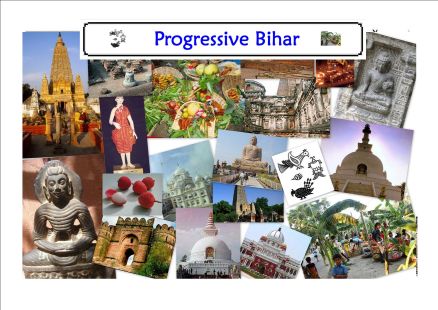While reading Preeti Mehta’s article “Tales of a Neglected Hinterland” I saw some general demographical statistics and hence decided to explore some more statistics and the findings were interesting.
· Out of a total area of 94,163 Sq Kms only 1.16% area is urban while the rest is rural.
· There is one police station for every 110 Sq km area and 1,21,694 people.
· There are 52.1 % males to 47.9% females i.e. 916 females for every 1000 males . In the age group of 0-6 the statistics seem to be a little better: There are 51.7% males to 48.3% females
Location
|
Bihar is located in the eastern part of the country (between 83°-30' to 88°-00' longitude). It is an entirely land–locked state, although the outlet to the sea through the port of Kolkata is not far away. Bihar lies mid-way between the humid West Bengal in the east and the sub humid Uttar Pradesh in the west which provides it with a transitional position in respect of climate, economy and culture. It is bounded by Nepal in the north and by Jharkhand in the south. The Bihar plain is divided into two unequal halves by the river Ganga which flows through the middle from west to east.
|
Physical Features
| |||||
Latitude
|
24°-20'-10" ~ 27°-31'-15" N
|
||||
Longitude
|
82°-19'-50" ~ 88°-17'-40" E
| ||||
Rural Area
|
92,257.51 sq. kms
| ||||
Urban Area
|
1,095.49 sq. kms
| ||||
Total Area
|
94,163.00 sq. kms
| ||||
Height above Sea-Level
|
173 Feet
| ||||
Normal Rainfall
|
1,205 mm
| ||||
Avg. Number of Rainy Days
|
52.5 Days in a Year
| ||||
Administrative Units
| |||||
Divisions
|
9
|
||||
Districts
|
38
| ||||
Sub-Divisions
|
101
| ||||
CD Blocks
|
534
| ||||
Panchayats
|
8,471
| ||||
Number of Revenue Villages
|
45,103
| ||||
Number of Urban Agglomerations
|
14
| ||||
Number of Towns
|
199
| ||||
- Statutory Towns
|
139
| ||||
- Non-Statutory Towns
|
60
| ||||
Police Stations
|
853
| ||||
- Civil Police Stations
|
813
| ||||
- Railway Police Stations
|
40
| ||||
Police Districts
|
43
| ||||
- Civil Police District
|
39
| ||||
- Railway Police District
|
4
| ||||
Key Statistics - as per 2011 Census (Provisional)
| |||||
Population
|
10,38,04,637
|
||||
- Male
|
5,41,85,347
| ||||
- Female
|
4,96,19,290
| ||||
Population (0~6 Years Group)
|
|||||
- In Absolute Numbers
|
1,85,82,229
| ||||
Males
|
| ||||
Females
|
| ||||
Literacy
|
|||||
- In Absolute Numbers
|
5,43,90,254
| ||||
Males
|
| ||||
Females
|
| ||||
- Percentage of Total Population
|
63.82%
| ||||
Males
|
| ||||
Females
|
| ||||
Decadal Population Growth (2001-2011)
|
|||||
- Absolute
|
2,08,06,128
| ||||
- As Percentage
|
25.07%
| ||||
Highest Decadal Growth at
|
Madhepura District
|
(30.65%)
| |||
Lowest Decadal Growth at
|
Gopalganj District
|
(18.83%)
| |||
Density of Population
|
1,102 per sq kms
| ||||
- Highest Density
|
Sheohar,
|
1882 per sq kms
| |||
- Lowest Density
|
Kaimur,
|
488 per sq kms
| |||
Most Populous District
|
Patna:
|
57,72,804
| |||
Least Populous District
|
Sheikhpura:
|
6,34,927
| |||
Sex Ratio (Females/Thousand Males)
|
916
| ||||
- Highest Ratio
|
(Gopalganj)
|
1,015
| |||
- Lowest Ratio
|
Munger and Bhagalpur)
|
(879
| |||
Highest Literacy Rate
|
Rohtas,
|
75.59%
| |||
Lowest Literacy Rate
|
Purnia,
|
52.49%
| |||
Average Population of a District
|
27,31,701
| ||||

I must say Prashant that your blog is really impressive. All the best!
ReplyDeleteThanks Kaalchintan. Appreciate it.
ReplyDeleteThe stats that you have provided is very insightful Prashant....It helps people understand the current state of affairs in Bihar to the exact decimal place....Thanks a lot
ReplyDeleteThanks BA@MSBLRankit
ReplyDeleteIt's a great effort from your side Prashant... we are always surfing net to more growth story of beloved Bihar
ReplyDeleteThanks Piyush Nimiyar
Thanks Piyush
ReplyDeleteThis Site is full of information and statistical data. A few words to say to the People of BIHAR. People should focus more on development than politics. Land disputes and constant leg-pulling and back stabbing each other will not help. We are responsible for our own fall.
ReplyDeleteThe current trend of political stability and economic spur will have to last at least 10 years more ie... till 2022. Only then will this spurt mean anything and BIHAR will Rise.
BIHAR Needs NITISH Jee.